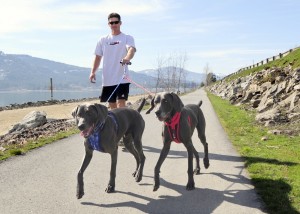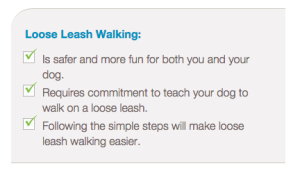 If your dog pulls on the leash whenever you walk, then those walks are neither healthy nor relaxing for either of you. Those walks aren’t safe either. When I see a dog who pulls on his leash during walks, I also see it as a sign that he and his owner are not paying attention to each other. It takes two to pull, after all. Walking with your dog should feel like a walking meditation, not a battle. Sadly, pulling on the leash can be very rewarding to a dog.
If your dog pulls on the leash whenever you walk, then those walks are neither healthy nor relaxing for either of you. Those walks aren’t safe either. When I see a dog who pulls on his leash during walks, I also see it as a sign that he and his owner are not paying attention to each other. It takes two to pull, after all. Walking with your dog should feel like a walking meditation, not a battle. Sadly, pulling on the leash can be very rewarding to a dog.
The action of pulling doesn’t feel so bad at the time and it often gets them where they want to go. Any behavior as rewarding as pulling on the leash takes a lot of commitment from the owner to fix. But trust me, it can be fixed and it will be worth it.
Below are some important keys for preventing and correcting leash pulling. If you have more than one dog, practice the following leash training techniques with each dog separately at first. Eventually you’ll be able to practice and walk them together more easily. Then everyone will have more fun.
Reward for Eye Contact. Using a clicker, practice walking on leash in the house, where your dog probably doesn’t pull. Each time he looks at you, click and give him a treat. Whenever you go on a walk, do the same. This helps bring your dog’s focus back to you, and it’s hard for him to pull if he’s looking at you. For more information on using a clicker to train your dogs, read my Introduction to Clicker Trainingarticle.
 Reward for Being in the Sweet Spot. Again, using a clicker on your walk, click and treat whenever he is in the area near your left leg – the “sweet spot.” It doesn’t have to be the left side, but that’s the traditional side. Just pick one side and stick with it. Soon he will begin to think that it is a very good thing to be near you on your left side. As time goes by, fade out the use of food by treating less frequently. You’ll need more treats if the distraction level goes up so be prepared.
Reward for Being in the Sweet Spot. Again, using a clicker on your walk, click and treat whenever he is in the area near your left leg – the “sweet spot.” It doesn’t have to be the left side, but that’s the traditional side. Just pick one side and stick with it. Soon he will begin to think that it is a very good thing to be near you on your left side. As time goes by, fade out the use of food by treating less frequently. You’ll need more treats if the distraction level goes up so be prepared.
Dance the Canine Cha-cha. Teach your dog that any pressure on the leash means that he should return to you. On your walk, even if he is not pulling, suddenly walk backwards. You are walking backwards and he turns around to face you, so he’s walking forwards, but the opposite direction of before. When he turns to look where his feet are taking him, give him a treat. Repeat – over and over and over. If he pulls ahead, back up as well. As time goes on, don’t reward him if it was his idea to pull, only if you suddenly walked back without him pulling ahead. This is not a collar correction, just a cue. Never jerk it to make it hurt. The goal is to make the cue tug gentler and gentler. Eventually a slight tug from you will signal your dog back into place. As time goes on, you will stop walking backwards, just reward your dog when you moves to your side and keep moving forward. This is similar to the Silky Leash technique I describe below. However, you can dance the canine cha-cha on your regular walk.
Feeding Tree. Dogs have a natural resistance to pressure, called the Opposition Reflex. This helps them get out of brambles that catch at their fur, but makes it hard for us to teach them to go into the direction of a pulling leash, not away from it. Leash pressure can be caused by a dog stopping while you walk ahead, pulling ahead of you, or by you changing directions. Do not allow your dog to go where he wants if he has caused the leash to tighten. You can simply stop and wait, making yourself as still as a tree. When the leash pressure eventually eases– you should feel this in your hand, though you can also see it by the way the leash begins to sag – click and give your dog a treat at your side. I encourage starting this inside the house. It’s best to combine the Feeding Tree with the Sweet Spot. Otherwise your dog may realize that he needs to pull on the leash to get treats.
Speed as a Treat. I think I made this one up; somebody correct me if I’m wrong. In Feeding Tree I suggested acting like a tree if your dog gets to the end of his leash. You can extend that technique into what I call Speed Training. In Speed Training you will walk most quickly when your dog is next to you in the position you’re teaching him is the Sweet Spot (for example, walking at 4mph, a swift walking pace). If your dog moves ahead of you at all, walk more slowly at 3mph. If your dog moves even further ahead, slow down even more to 2 or even 1mph. Slightly before your dog arrives at the end of the leash, slap your thigh or say something like “easy” to give an audio warning. If your dog reaches the end, either stop or do the Canine Cha-Cha. At first, you might find it easiest to have your maximum speed be one where you run. Most dogs find that enjoyable. As the weeks go by, feel free to gradually slow down to a more comfortable. Although maybe you’ll enjoy running by then! By inserting the word “Run!” or “Quickly!” just before you speed up, you can also teach your dog to walk fast on cue – great for when you spot that neighbor who always wants you to stop and chat longer than you’d like!
Focused Walking. Teach your dog to follow your finger, as a fun game. This is your defense against cats, children, dogs, and other distractions. Let’s say your dog is on your left, leash in your right hand. Put the clicker in your right hand as well and load your left hand with treats. Put one finger out on the treat hand, like you were pointing at something. Encourage your dog to chase that finger (remember, this is a fun game, not a boring obedience exercise!) Click and treat right as they get close to the hand target. After about ten times in a quiet setting, your dog will probably follow the target finger with no food in the target hand. Click and feed your dog a treat from somewhere else, like your right hand. You’ll need to work on being able to stand up straight while your dog does this. If she jumps, just click when she’s on the floor to help her learn to stay on the floor more. Remember, dogs do what works! If staying on the floor earns more treats than jumping earns, your dog will learn to stay on the floor.
Work on Your Relationship. Pulling on the leash can be a sign that your relationship with your dog could use a little tweaking. Do you demand that he pay attention to you without you paying attention to him? One way to improve your relationship is to consistently ask your dog to “Say Please” by sitting and looking at you to get what he wants. On a walk, for example, you can ask him to sit and look at you before he is allowed to take a long time sniffing something fascinating.
Silky Leash. This is another highly effective technique to teach loose leash walking through positive reinforcement. In the Silky Leash technique you’ll reinforce through clicking and treating. This teaches your dog to pay attention and respond a certain way to gentle (as in “wouldn’t break a stand of silk”… hence, “silky”) pressure on their collar or harness. Click the link to read more and watch my videos demonstrating the Silky Leash technique.
Set Your Dog Up for Success. For all of the above techniques, always start in situations where your dog will be successful. If you take him out to train and he is just a basket case, pulling every which way, he is not going to learn, and you will just become frustrated. Believe me, I’ve been there! Back up a step or two. Work inside your home with only a few distractions. Then, work in your yard or right in front of your home. Make your training walks longer and longer. And lastly, always strive to avoid distractions that your dog isn’t ready for. Avoid the house that has three dogs in the front yard or the street where there is a lot of traffic if you know your dog isn’t ready for those.
There are many training aids you can use when working towards teaching your dog loose leash walking. Some are better than others, and some are even outright dangerous. For my recommendations about harnesses please read my Dog Harnesses: Helpful Tools for Loose Leash Walking article.
